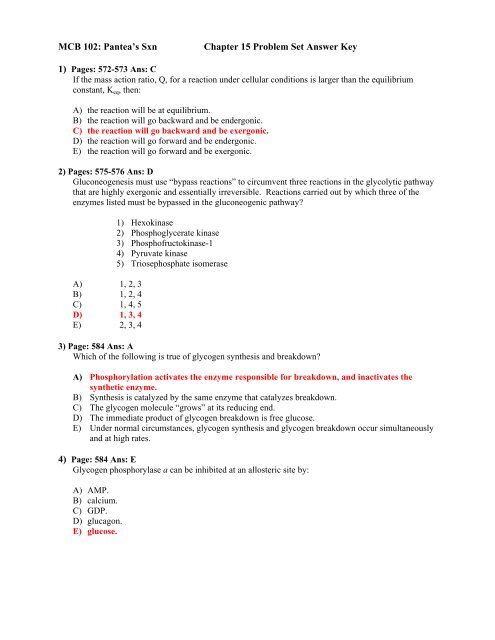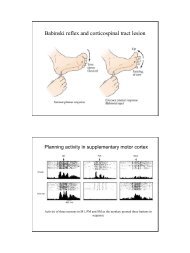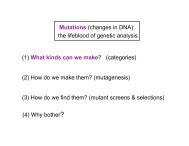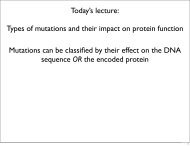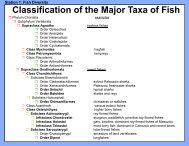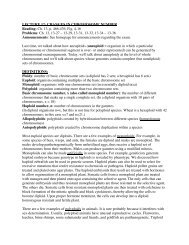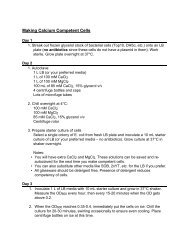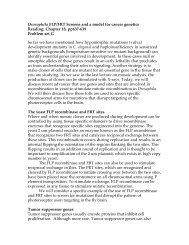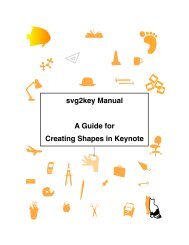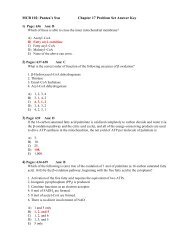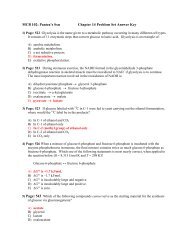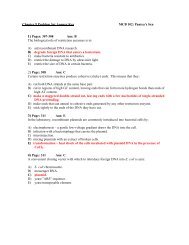MCB 102: Pantea's Sxn Chapter 15 Problem Set Answer Key
MCB 102: Pantea's Sxn Chapter 15 Problem Set Answer Key
MCB 102: Pantea's Sxn Chapter 15 Problem Set Answer Key
You also want an ePaper? Increase the reach of your titles
YUMPU automatically turns print PDFs into web optimized ePapers that Google loves.
<strong>MCB</strong> <strong>102</strong>: Pantea’s <strong>Sxn</strong> <strong>Chapter</strong> <strong>15</strong> <strong>Problem</strong> <strong>Set</strong> <strong>Answer</strong> <strong>Key</strong><br />
1) Pages: 572-573 Ans: C<br />
If the mass action ratio, Q, for a reaction under cellular conditions is larger than the equilibrium<br />
constant, Keq, then:<br />
A) the reaction will be at equilibrium.<br />
B) the reaction will go backward and be endergonic.<br />
C) the reaction will go backward and be exergonic.<br />
D) the reaction will go forward and be endergonic.<br />
E) the reaction will go forward and be exergonic.<br />
2) Pages: 575-576 Ans: D<br />
Gluconeogenesis must use “bypass reactions” to circumvent three reactions in the glycolytic pathway<br />
that are highly exergonic and essentially irreversible. Reactions carried out by which three of the<br />
enzymes listed must be bypassed in the gluconeogenic pathway?<br />
A) 1, 2, 3<br />
B) 1, 2, 4<br />
C) 1, 4, 5<br />
D) 1, 3, 4<br />
E) 2, 3, 4<br />
1) Hexokinase<br />
2) Phosphoglycerate kinase<br />
3) Phosphofructokinase-1<br />
4) Pyruvate kinase<br />
5) Triosephosphate isomerase<br />
3) Page: 584 Ans: A<br />
Which of the following is true of glycogen synthesis and breakdown?<br />
A)<br />
B)<br />
C)<br />
D)<br />
E)<br />
Phosphorylation activates the enzyme responsible for breakdown, and inactivates the<br />
synthetic enzyme.<br />
Synthesis is catalyzed by the same enzyme that catalyzes breakdown.<br />
The glycogen molecule “grows” at its reducing end.<br />
The immediate product of glycogen breakdown is free glucose.<br />
Under normal circumstances, glycogen synthesis and glycogen breakdown occur simultaneously<br />
and at high rates.<br />
4) Page: 584 Ans: E<br />
Glycogen phosphorylase a can be inhibited at an allosteric site by:<br />
A) AMP.<br />
B) calcium.<br />
C) GDP.<br />
D) glucagon.<br />
E) glucose.
5) Page: 586 Ans: B<br />
Which one of the following directly results in the activation of glycogen synthase?<br />
A) Binding of glucose-6-phosphate<br />
B) Dephosphorylation of multiple residues by phosphoprotein phosphorylase-1 (PP1)<br />
C) Phosphorylation of specific residues by casein kinase II (CKII)<br />
D) Phosphorylation of specific residues by glycogen synthase kinase-3 (GSK-3)<br />
E) The presence of insulin<br />
6) Pages: 586-588 Ans: E<br />
Which one of the following is not a characteristic of phosphoprotein phosphorylase-1 (PP1)?<br />
A) PP1 can be phosphorylated by protein kinase A (PKA).<br />
B) PP1 can dephosphorylate glycogen phosphorylase, glycogen synthase, and phosphorylase kinase.<br />
C) PP1 is allosterically activated by glucose-6-phosphate.<br />
D) PP1 is inhibited by activated glycogen phosphorylase<br />
E) PP1 is phosphorylated by glycogen synthase kinase-3 (GSK3).<br />
7) Pages: 562, 568, 584, 586<br />
Glycogen synthesis and glycogen breakdown are catalyzed by separate enzymes. Contrast the<br />
reactions in terms of substrate, cofactors (if any), and regulation.<br />
Ans: Glycogen synthesis is catalyzed by glycogen synthase and employs UDP-glucose as the<br />
activated precursor:<br />
UDP-glucose + glycogen (glucose) n ⎯→ UDP + glycogen (glucose) n+1<br />
Glycogen synthase is inactivated by phosphorylation, catalyzed by cAMP-dependent protein<br />
kinase; it is activated by dephosphorylation, catalyzed by phosphoprotein phosphatase.<br />
Glycogen breakdown is catalyzed by glycogen phosphorylase, which employs pyridoxal<br />
phosphate (PLP) as a cofactor. The reaction is a phosphorolysis; the glycosidic bond is broken<br />
by the attack of Pi:<br />
Glycogen (glucose) n + Pi ⎯→ glycogen (glucose) n –1 + glucose 1-phosphate.<br />
Glycogen phosphorylase is activated by phosphorylation, catalyzed by phosphorylase kinase,<br />
and it is inactivated by dephosphorylation, catalyzed by phosphorylase a phosphatase.<br />
8) Pages: 567-569<br />
Diagram the pathway from glucose to glycogen; show the participation of cofactors and<br />
name the enzymes involved.<br />
Ans:<br />
(1) Glucose + ATP ⎯⎯⎯⎯→ glucose 6-phosphate + ADP<br />
hexokinase<br />
(2) Glucose 6-phosphate ⎯⎯⎯⎯→ glucose 1-phosphate<br />
phosphoglucomutase<br />
(3) Glucose 1-phosphate + UTP ⎯⎯⎯⎯→ UDP-glucose + PPi<br />
UDP-glucose<br />
pyrophosphorylase<br />
(4) UDP-glucose ⎯⎯⎯⎯→ glycogen + UDP<br />
glycogen synthase
9) Page: 568<br />
Show the reaction catalyzed by glycogen synthase.<br />
Ans: The reaction is the addition of a glucose moiety from UDP-glucose to the nonreducing end<br />
of a glycogen chain; the linkage formed is (α1 → 4). (See Fig. <strong>15</strong>-8, p. 568.)<br />
10) Page: 568<br />
What is the biological advantage of synthesizing glycogen with many branches?<br />
Ans: Highly branched glycogen is more soluble than unbranched glycogen. In addition, both<br />
glycogen synthase and glycogen phosphorylase act at the nonreducing ends of glycogen chains.<br />
Branched glycogen has far more ends for these enzymes to work on than would the equivalent<br />
amount of linear glycogen chains. Having more ends effectively increases the concentration of<br />
substrate for the enzymes, thereby increasing the rate of glycogen synthesis and breakdown.<br />
11) Page: 568<br />
Show all of the reactions that occur in the pathway from galactose to glycogen in an adult human.<br />
You do not need to give structures or name enzymes; just name the intermediates along the path and<br />
show any required cofactors.<br />
Ans:<br />
(1) Galactose + ATP ⎯→ Galactose 1-phosphate + ADP<br />
(2) Galactose 1-phosphate + UDP-glucose ⎯→ UDP-galactose + glucose 1-phosphate<br />
(3) UDP-galactose ⎯→ UDP-glucose (catalyzed by UDP-glucose epimerase, which requires<br />
NAD +<br />
)<br />
(4) UDP-glucose + glycogen (glucose)n ⎯→ UDP + glycogen (glucose) n +1<br />
(For galactose metabolism, see Fig. 14-11, p. 537.)<br />
12) Pages: 572-573<br />
In the glycolytic path from glucose to phosphoenolpyruvate, two steps are practically irreversible.<br />
What are these steps, and how is each bypassed in gluconeogenesis? What advantages does an<br />
organism gain from having separate pathways for anabolic and catabolic metabolism? What are the<br />
disadvantages?<br />
Ans: The two irreversible steps in glycolysis are conversion of glucose to glucose 6-phosphate,<br />
catalyzed by hexokinase, and conversion of fructose 6-phosphate to fructose 1,6-bisphosphate,<br />
catalyzed by phosphofructokinase-1 (Table <strong>15</strong>-2, p. 573). The first reaction is bypassed during<br />
gluconeogenesis by the reaction catalyzed by glucose 6-phosphatase, an enzyme unique to the<br />
liver. The second is bypassed by fructose 1,6-bisphosphatase-1 (FBPase-1). By having separate<br />
pathways that employ different enzymes, an organism is able to control anabolic and catabolic<br />
processes separately, thus avoiding futile cycles. A potential disadvantage is the need to<br />
produce separate sets of enzymes for catabolism and anabolism.<br />
13) Pages: 579-581<br />
Why is citrate, in addition to being a metabolic intermediate in aerobic oxidation of fuels, an<br />
important control molecule for a variety of enzymes?<br />
Ans: As the key biochemical intermediate in the citric acid cycle resulting from the<br />
condensation of oxaloacetate and acetyl-CoA, citrate is at a junction of amino acid, fatty acid,<br />
and pyruvate oxidation, serving as an intracellular signal that the cell’s current energy needs<br />
are being met. In particular, it is an allosteric regulator of PFK-1, increasing the inhibitory<br />
effect of ATP, and further reducing the flow of glucose through glycolysis.
14) Page: 590<br />
Order the steps leading to glycogen breakdown resulting from the stimulation of liver cells by glucagon.<br />
1) Activation of protein kinase A (PKA)<br />
2) cAMP levels rise<br />
3) Phosphorylation of phosphorylase b<br />
4) Phosphorylation of phosphorylase b kinase<br />
5) Stimulation of adenyl cyclase<br />
Ans: The correct temporal order is 5-2-1-4-3.<br />
<strong>15</strong>) Page: 593<br />
Explain the distinction between metabolic “regulation” and metabolic “control” in a multienzyme<br />
pathway.<br />
Ans: Regulation refers to rebalancing the levels of metabolites along a pathway in response to a<br />
change in flux through the pathway, while control is what determines the total flux through the<br />
pathway


